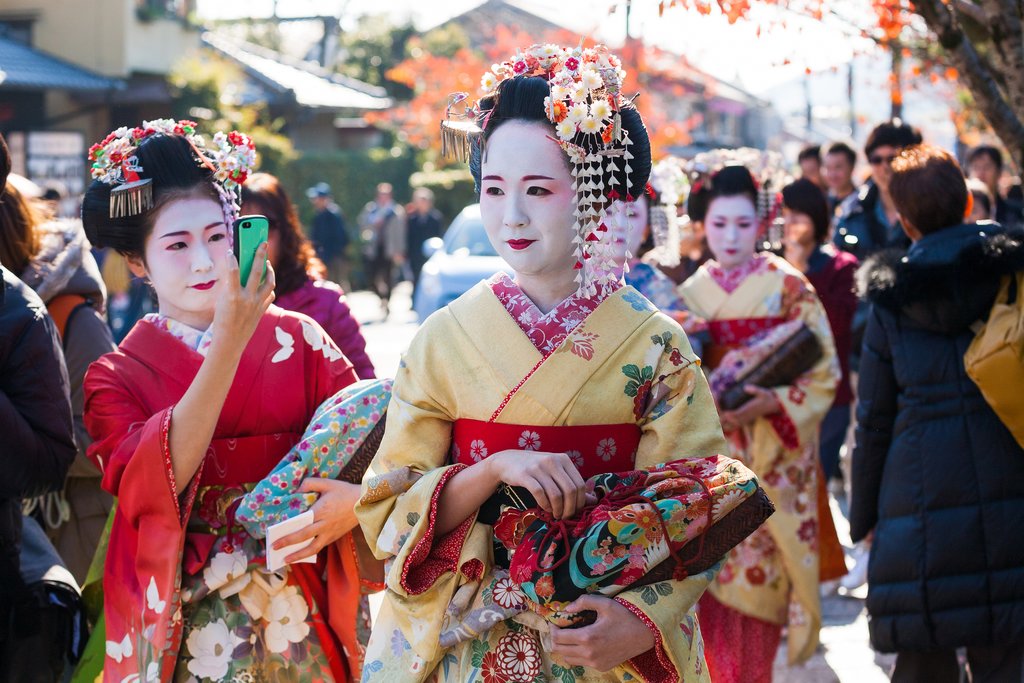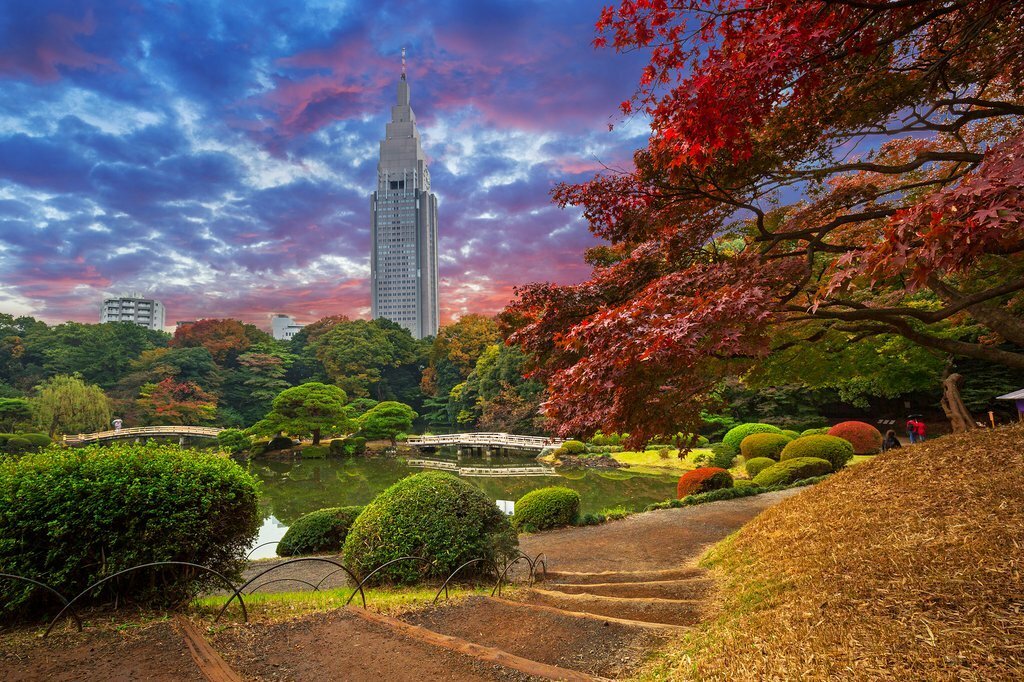Highlights
- Enjoy private guided tours of Tokyo and Kyoto
- Stay at a traditional "ryokan" (inn) on the sacred island of Miyajima
- Explore the countryside by bicycle near Takayama
- Taste sake in a historic sake brewery
- See the historic thatched-roof farmhouses of Shirakawa-go
Brief Itinerary
| Day | Highlights | Overnight |
|---|---|---|
| Day 1 | Arrive in Tokyo | Tokyo |
| Day 2 | Enjoy a Guided Tour of Tokyo | Tokyo |
| Day 3 | Discover Hiroshima's History | Hiroshima |
| Day 4 | Boat to Miyajima Island | Miyajima |
| Day 5 | Relax in Kyoto | Kyoto |
| Day 6 | Go on a Guided Tour of Kyoto | Kyoto |
| Day 7 | Learn About Traditional Arts in Kyoto | Kyoto |
| Day 8 | Day Trip to Nara | Kyoto |
| Day 9 | Go Back in Time in Takayama | Takayama |
| Day 10 | Cycle in the Countryside | Takayama |
| Day 11 | See the Historic Farmhouses of Shirakawa-go | Shirakawa |
| Day 12 | Wander Through Landscaped Gardens in Kanazawa | Kanazawa |
| Day 13 | Revel in One Last Night on the Town in Tokyo | Tokyo |
| Day 14 | Depart Tokyo |
Detailed Itinerary
Day 1: Arrive in Tokyo

Welcome to Japan! Get oriented in Tokyo with a visit to the world's tallest tower. At 2,080 feet (634 m), the Tokyo Skytree offers spectacular views as far as Mount Fuji from its 360-degree observation deck. Afterward, take a walk through the grounds of Sensoji, the city's oldest and most historically significant temple. Legends say it was founded when two brothers fished a statue of the goddess Kannon out of the Sumida River. The neighboring Asakusa Shrine also highlights the stark differences between Shinto and Buddhist belief systems.
As night falls, make your way to Shibuya, home to the vibrant Shibuya Crossing. The area is packed with restaurants, bars, and nightclubs, perfect for a night out on the town.
Day 2: Enjoy a Guided Tour of Tokyo

Your private local guide will meet you in the morning for a tour of the capital. Explore the artificial island of Odaiba, a hot spot for futuristic fun. The trip to this shopping and entertainment district is enjoyable, whether you arrive by taking a cruise through Tokyo Bay or by crossing the colorful Rainbow Bridge. Start at TeamLab, a permanent interactive art exhibition on the island that gives new meaning to the term "modern art"—be prepared to follow art as it moves along the walls.
Then head to the trendy fashion mecca of Harajuku. As you walk through the famous Takeshita Street, be sure to stop by the rainbow candyfloss and crepe stands, as well as the fascinating costume galleries and animal and character cafés. A visit to the world-famous Kawaii Monster Café is a great way to get a glimpse of Japan's Kawaii culture. The brightly colored food, live performances from waitresses dressed like cartoon characters, and vibrant decor make it a unique and memorable experience.
Stop at the Meiji Jingu shrine, one of Tokyo's most spiritually significant religious structures, for a brief respite from the lights and action. Take a stroll through its forested grounds and witness the contrast between these two areas—modern and traditional—located so close together. It's a perfect representation of the diversity of Tokyo.
You'll then walk to Shibuya to enjoy another one of the country's most famous sights, Shibuya Crossing. Featured in several films, like "The Fast and the Furious: Tokyo Drift" and "Lost in Translation," there can be as many as 2,500 people crossing at one time! Shibuya is also packed with some of the best nightclubs in the country. After dinner, dance and socialize in this suburb that never sleeps!
Day 3: Discover Hiroshima's History

You'll take the bullet train west today to coastal Hiroshima, a modern city of wide boulevards, flowing rivers, and a lively downtown. Of course, it's a tragic legacy that sets this city apart: Hiroshima was the world's first city destroyed by an atomic bomb during World War II. (The second was Nagasaki.) You'll learn about this 1945 event at the Peace Memorial Park, which features the ruins of Genbaku Dome, one of the only buildings that were left standing after the blast. Stroll through Shukkei-en, a Japanese garden, and stop by the beautifully landscaped fortress of Hiroshima Castle.
Day 4: Boat to Miyajima Island

Today, you'll take a train and a ferry to reach the island of Miyajima. On the short ferry ride there, be sure to stand on the deck to get a good view of the giant red torii gate rising out of the sea. Miyajima holds the rare distinction in Japan of having never experienced an earthquake. Because of this, many of its temples are entirely original and centuries old. Be sure to visit Daisho Temple, Itsukushima Shrine, and Mount Misen. The view from the top of the mountain is superb, looking out across the inland sea.
The island is also populated with friendly deer, which only adds to the fairytale-like setting. You'll spend the night at a ryokan, or traditional inn, where you'll dine on a gourmet multi-course meal (kaiseki) featuring locally sourced oysters.
Day 5: Relax in Kyoto

Head back east today to Kyoto, the enchanting former imperial capital of Japan. Overflowing with history and a lot more traditional than its Tokyo counterpart, things here move at a slower pace, and the people tend to be more laid-back. While here, a visit to what is arguably the most famous shrine in Japan, Fushimi Inari, is an absolute must. Featured in the movie Memoirs of a Geisha, this shrine has more than 10,000 picturesque red torii gates. They were all donated by Japanese individuals and businesses as a sign of appreciation to the god Inari for the blessings received.
Chat with a local specialist who can help organize your trip.
Day 6: Go on a Guided Tour of Kyoto

Today, a local guide will meet you in your hotel lobby to show you around some of Japan's most beautiful and historic temples and shrines. Though there isn't time to see and do it all in one day, so you'll likely want to focus on the district of Higashiyama—one of the eleven wards in the city—to see the UNESCO-listed Kiyomizudera. Observe colorful geisha girls wearing kimonos as they walk to their next appointment, then head north to Kinkakuji, a Zen temple in northern Kyoto with the top two floors completely covered in gold leaf.
Day 7: Learn About Traditional Arts in Kyoto

Your next stop is a traditional Japanese art show. As well as offering a chance to see a performance by a maiko (geisha in training), this hourlong theatrical experience also introduces you to various skilled artists, including ikebana (flower arrangers), puppeteers, koto (Japanese harp players), and court musicians. In the evening, talk a walk through the bustling streets of Pontocho. Right next to the Kamogawa River, this area is home to a wide range of restaurants and bars. You can also request a private dinner or tea ceremony with a geisha if you prefer.
Alternatively, take a day trip to the peaceful bamboo grove of Arashiyama on the outskirts of the city. Walk among the towering stalks before visiting the Tenryui-ji temple. Then take a boat cruise down the Hozugawa River to see the area's natural beauty in all its glory.
Day 8: Day Trip to Nara

Today you'll side-trip to the city of Nara, famous for its traditional sites and resident herds of peaceful deer. With scenic gardens, parks, temples, and shrines, it's a quiet place that you'll enjoy exploring at your own pace. Nara also has some stunning walking trails, one of which will take you through Mount Kasuga Primeval Forest. The Todaiji Temple, home to the giant Daibutsu Buddha statue, is a must-see. Then head to Naramachi, the city's former merchant district, to see traditional homes and buildings preserved from as far back as the early 1600s.
Day 9: Go Back in Time in Takayama

Make your way to Takayama today for a change of pace. This mountain city is sometimes called "Little Kyoto" for its well-preserved historical buildings. You'll explore the Old Town and Sannomachi Street, where you'll find traditional homes, shops, restaurants, and sake breweries, some of which have been in operation for centuries. Many of the buildings have been turned into museums, offering visitors the chance to see how merchants lived in this remote part of Japan during the Edo Period (1603 to 1868).
Day 10: Cycle in the Countryside

This morning you'll take the train out to the town of Hida Furukawa to join a small, guided group for a bicycle tour of the countryside. You'll pedal through rice fields and villages with excellent views of the surrounding mountain landscape. The pace will be relaxed, and you'll have plenty of opportunities to stop and take photos along the way. Return to Takayama for dinner and to stay overnight once more.
Day 11: See the Historic Farmhouses of Shirakawa-go

Shirakawa-go, located in the Ono district of Gifu prefecture, was registered as a UNESCO World Heritage Site in 1995. The village's main attraction is its collection of gassho-zukuri (traditional farmhouses). The houses' steeply angled and thatched roofs were designed to weather heavy snow that falls in the region every winter. Some of these farmhouses offer overnight accommodations. Wander through the streets of the village and stop at the Myozenji Temple Museum. The Buddhist temple at the heart of the site dates back more than 200 years. Today, you can tour the monk's residence, bell tower gate, and main hall.
Day 12: Wander Through Landscaped Gardens in Kanazawa

Grab a seat on Japan's newest bullet train to the city of Kanazawa in Japan's Hida Mountains. A center of art and culture that's famous for gold leaf production, Kanazawa is home to a range of museums and monuments. Don't miss the 21st Century Museum of Contemporary Art and a stroll through the lovely Kenroku-en Garden, considered one of the most beautiful in all of Japan. Later, take a break at Omicho Market for fresh sushi and sashimi. Take some time to visit one of the city's many sake breweries to sample Japan's national drink before getting some rest at your hotel in the city.
Day 13: Revel in One Last Night on the Town in Tokyo

Spend the morning enjoying Kanazawa. Then take the bullet train back to Tokyo for the evening, passing the magnificent Mount Fuji on the way. It's your last night in Japan, so it's a perfect excuse to indulge in a special dinner at one of the capital city's famous restaurants. Or attend one of Tokyo's wackiest shows at the Robot Restaurant. Less of a culinary adventure and more of a theatrical experience, this 90-minute show is jam-packed with neon lights and vibrant music and is a great way to experience Japan's techno culture. Afterward, weave in and out of the alleys of the famous Golden Gai district, stopping in some of the area's hundreds of bars.
Day 14: Depart Tokyo

After breakfast, it's time to say goodbye to Japan. Come back again soon! Safe travels!
More Great Japan Itineraries
Looking for more inspiration for your trip to Japan? Check out these other Japan itineraries, explore different ways to spend two weeks in Japan, or discover the best time to visit Japan.








